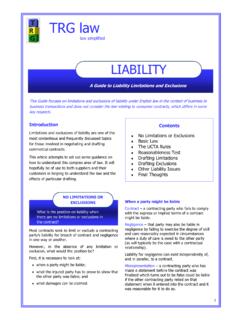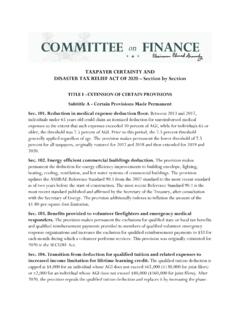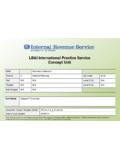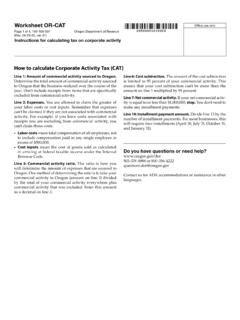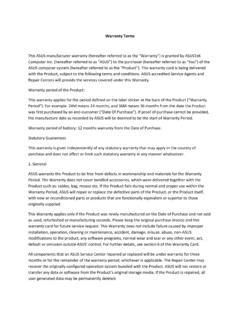Transcription of TRG law - A Guide to Liability Limitations and Exclusions ...
1 1 Introduction Limitations and Exclusions of Liability are two of the most contentious and frequently discussed topics for those involved in negotiating and drafting commercial contracts. This article attempts to set out some guidance on how to understand this complex area of law. It will hopefully be of use to both suppliers and their customers in helping to understand the law and the effects of particular drafting. Contents No Limitations or Exclusions Basic Law The UCTA Rules Reasonableness Test Drafting Limitations Drafting Exclusions Other Liability Issues Final Thoughts Liability A Guide to Limitations and Exclusions of Liability What is the position on Liability when there are no Limitations or Exclusions in the contract?
2 NO Limitations OR Exclusions Most contracts seek to limit or exclude a contracting party s Liability for breach of contract and negligence in one way or another. However, in the absence of any limitation or exclusion , what would the position be? First, it is necessary to look at: when a party might be liable; what the injured party has to prove to show that the other party was liable; and what damages can be claimed. When a party might be liable Contract a contracting party who fails to comply with the express or implied terms of a contract might be liable. Negligence that party may also be liable in negligence by failing to exercise the degree of skill and care reasonably expected in circumstances where a duty of care is owed to the other party (as will typically be the case with a contractual relationship).
3 Liability for negligence can exist independently of, and in parallel, to a contract. Misrepresentation a contracting party who has made a statement before the contract was finalised which turns out to be false could be liable if the other contracting party relied on that statement when it entered into the contract and it was reasonable for it to do so. TRG law law simplified This Guide focuses on Limitations and Exclusions of Liability under English law in the context of business to business transactions. It does not consider the law relating to consumer contracts, which differs in some key respects. 2 TRG law law simplified What does the injured party have to prove? Assuming that a breach of contract, negligence or a misrepresentation can be proved, the injured party must then establish that: the breach, negligence or misrepresentation in question actually caused the damage suffered by the injured party; and the type of damage suffered passes the remoteness test.
4 Inset box below What damages can be claimed? For breach of contract, an injured party may seek to recover: the benefit which it expected to receive had the contract been performed in accordance with its terms. This benefit can be assessed either on: In contract, the test of remoteness enables injured parties to recover: losses arising naturally from the breach in the normal course of events; and such losses as may reasonably be supposed to have been in both parties contemplation when they made the contract, as a probable result of the breach. For negligence, the test of remoteness is simply that the damage must be reasonably foreseeable (ie damage which a reasonable person could anticipate as the result of the negligence). For misrepresentations, there are different tests for remoteness depending on whether the misrepresentation claimed was innocent, negligent or fraudulent.
5 Does the scale of damage matter? No, generally it is the type of loss which has to be foreseen or contemplated in order to be recoverable not the precise detail or the extent of the damage. Once the type of loss is established as not being too remote, it should be possible to claim for all loss of that type, although recently some very senior judges have stated that this will not always be the case. WHAT IS THE REMOTENESS TEST ? the basis of the difference in value between what was delivered and what should have been delivered; or the cost of curing the breach; or wasted expenditure incurred in anticipation that the contract would be performed. Traditionally, the injured party had to choose between these alternative bases but recently there has been some slight relaxation of that rule provided the Court is satisfied there will be no element of double recovery.
6 For negligence, an injured party may try to claim damages to put it back into the position it was in before the negligence occurred. For misrepresentation, in most cases an injured party may seek to recover damages on the same basis as for negligence. The principal function of damages for breach of contract, negligence and misrepresentation is to compensate the injured party. Some losses that are recoverable Loss of profit will often be a direct loss and therefore can be claimed. In principle, the cost of wasted management or staff time is recoverable as a type of damage that can be claimed if an injured party can establish that management or staff have been significantly diverted from their usual activities. Losses that are not recoverable The injured party cannot claim damages for any part of its loss which it could have avoided by taking reasonable steps.
7 This is referred to as the duty to mitigate . inset box below The duty to mitigate is not an onerous one but the injured party: must take reasonable steps to minimise its loss; and must not take unreasonable steps to increase the loss. Where the injured party incurs expenses or suffers loss due to taking reasonable steps to mitigate, it can recover those expenses or losses. WHAT IS THE DUTY TO MITIGATE? 3 TRG law law simplified Potential Liability if there is no exclusion or limitation of Liability So assuming a defaulting party is liable and the other party can prove this, if there are no Exclusions or Limitations on the defaulting party s Liability in the contract, then the potential Liability can be very significant. In particular the compensation awarded: can be entirely unrelated to the value of the contract or the level of profit expected by the party in breach; and for the same breach may vary considerably according to the particular individual circumstances of the injured party.
8 It is therefore perhaps not too surprising that contracting parties look to limit or exclude their Liability as a matter of routine. There are three main points to consider here: incorporation; effectiveness; and legal restrictions. Incorporation is the exclusion or limitation validly incorporated into the contract? An exclusion or limitation provision will be assumed to be incorporated if it is included within a signed, written agreement. Otherwise, reasonable steps must be taken to bring the exclusion or limitation to the notice of the other party before the contract is made. Generally, no particular special steps need to be taken to make sure that exclusion or limitation clauses are validly incorporated and the threshold for incorporating standard terms into a contract with a business customer is not particularly high.
9 Inset box opposite above Effectiveness - is the exclusion or limitation effective to cover the breach? The party seeking to rely upon the exclusion or limitation must prove that it is effective in covering the breach in question. A Liability clause, for example, must therefore specifically deal with all possible bases of Liability such as: breach of contract; negligence; misrepresentation; and both acts and omissions. Failure to refer to negligence explicitly would be a serious mistake because, for example, an exclusion or limitation in relation to any loss may not be sufficient to cover losses resulting from negligence. Legal restrictions - does the law impose any constraints on one party s ability to exclude or limit its Liability to the other? The starting point under English law is that the parties are free to agree the terms of their contract between them.
10 However, there are some legal constraints on this freedom - a contracting party cannot exclude or restrict Liability at all for: fraud - exclusion or limitation clauses will not be effective if they exclude or limit Liability for fraud or fraudulent misrepresentation as a matter of public policy. This is why in one recent notable case, the injured party successfully managed to prove that the supplier s salesman had been deliberately dishonest amounting to fraud. The result was that the supplier was not able to rely on its limitation of Liability clause; death or personal injury caused by negligence; breach of the conditions implied by statute in sale of goods contracts that the seller has good title to the goods and that they are not subject to any form of impediment.
